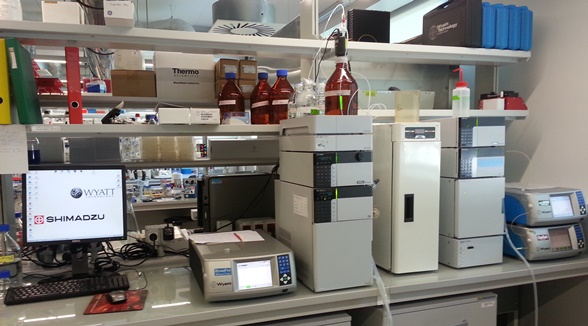Protein Analysis On Line (PAOL)
Presentation

PAOL couples an exclusion chromatography and different detectors, static and dynamic light scattering, refractive index and absorbance. PAOL combines the separation of macromolecules and their characterization. See the technical and scientist description. It allows :
- Quantifying the homogeneity of the preparations.
- Determining the stoichiometry of complexes, including for complex systems associating protein-detergent, protein-RNA, protein-polymer. It is a method often appropriated for studying interactions of membrane protein and/or glycosylated proteins.
The AUC platform is committed to the establishment of a quality approach implementation that resulted in June 2011 with the ISO 9001 (2008) and in July 2015 with NF X50-900 (2015).
Key words
High-pressure liquid chromatography, size-exclusion chromatography, static light scattering, homogeneity, molar mass, composition.
StaffSpecific equipment- High pressure liquid chromatography : LC20 AD (Shimadzu)
- Photodiode array UV detector : SPDM-20A (Shimadzu)
- Refractometer : Optilab rEX (Wyatt)
- Multi-angle light scattering detector : miniDAWN TREOS (Wyatt)
- Dynamic light scattering detector : Dynapro Nanostar (Wyatt)
- Columns : KW 802.5, KW 803 and KW 804 (Shodex) ; WTC050N5 (Wyatt) ; Superdex 200 and75, Superose 6 10/300 GL (GE Healthcare)
- Auto sampler ; temperature regulation 4-40° (SIL-20 AC HT Shimadzu).
- Collector ; temperature regulation 4-20° (FRC10A/sample cooler Shimadzu).
- Column oven (4-30° in favorable conditions) (XLT-01 Winsep).
- Airfuge Ultracentrifuge (Beckman)
- Used software : LC Solution (Created by Shimadzu Corporation) ; ASTRA and Dynamics (Created by Wyatt Technology Corporation).
Reliability tests are frequently performed on the instruments :
- Each year : Test of the resolution of the columns with standart proteins. Annual maintenance of the LC20 AD pump (Shimadzu) and the Mini DAWN TREOS detector (Wyatt)
- Each day of experiments : control of the detectors (noise, baseline, light intensity…)
Access mode- Open to academics, which will be trained to data analysis.
- Open to academics and private companies for the realisation of the analysis, on a service or collaboration mode, depending on equipment and staff availablility.
- Open to academics and private companies in the mode of access to the instrumentation after training.
How to make a request ?
Each new project manager should contact should contact Aline Le Roy or Christine Ebel. Each user will get trained to the analysis and agrees to comply with the general terms and commitment of PAOL.
All applications should be accompanied by a request form. The applicant should fill the fist part, which is completed in agreement by both part, in order to define the best way to conduct the experiments, before signature of the parts. A local contact will be associated and available for the users for the duration of the use of PAOL, for advices and assistance. It is obligatory to fill a sample form if the analysis are realized by the staff of the platform, and highly recommended in all cases. If samples are sent, or stored by the plateform, storing is as defined by the applicant in the sample file (to be filled and given with the samples).
Contact and localisationSamples- Only non-pathogenic biological samples are accepted. Decree of the July 18, 1994 establishing the list of biological pathogens, amended by Decrees of April 17, 1997 and June 30, 1998 (Decrees in French). The list of biological pathogens is available on the website of the IPBS.
- The sample is typically at 1-10 mg/mL ; the typical volume is 50 µl. The samples must be centrifuge during 5-10 min with the Airfuge (Cf. protocol : Airfuge) - eventually, for heat-unstable samples, at 13 000xg during 30 min-, or filtered at 0.1µm. Samples are not stored –unless specific request.
- The elution buffer must be filtered at 0.1µm. It contains typically 100mM salt ; silica columns require a pH in the range 3 - 7.5. Our standard buffer is PBS : 30mM Na Phosphate pH 6.8, 100 mM NaCl, 0.3 g/L NaN3.
Report-results- User access : Each user analyse his results using the programs LC Solution, ASTRA and Dynamics available on the instrument. Some data can be exported as text or excel files. The instrument PAOL is connected to the internal network of IBS for facilitating printing and saving the results. Each user should save his data and analysis after the experiments. Raw data are stored for three years on the computers of IBS. After that time, they can be deleted without notice. The user is responsible for definitive archiving. Data confidentiality is not protected –unless request.
- Experiments and analysis by the platform : Delay between experiments and report is typically some days. The report is checked by the responsible and sent by Email. Results are delivered by Email, with raw data and related files. Data are saved and archived for three years.
Cost- Academics : participation to maintenance fees ; private companies : quotation under request.
Follow up / Development- In the general case users and applicants must mention the platform in their publications : « This work used the platforms of the Grenoble Instruct-ERIC center (ISBG ; UAR 3518 CNRS-CEA-UGA-EMBL) within the Grenoble Partnership for Structural Biology (PSB), supported by FRISBI (ANR-10-INBS-0005-02) and GRAL, financed within the University Grenoble Alpes graduate school (Ecoles Universitaires de Recherche) CBH-EUR-GS (ANR-17-EURE-0003). We thank Aline Le Roy, and/or Michel Thépaut and/or Christine Ebel, for assistance and/or access to the Protein Analysis On Line (PAOL) platform ».
- The person responsible for the platform is a co-author of the papers if he participates to redaction.
List of our book chapters, protocols, and methodological publications concerning AUC, SEC-MALS and SANS
 - List of publications
|


